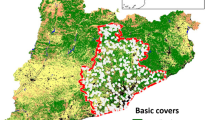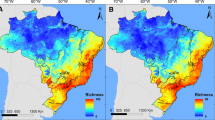Abstract
As the extremity of Arctic climate lessens with global warming, the risk of invasion increases. We assess the presence of introduced plant species and their persistence (since the previous survey) in a Canadian subpolar site on the Hudson Bay with a history of human introductions from large-scale grain inputs. Widespread sampling was done to locate all introduced plant species in the Churchill, MB, Canada area. We quantified edaphic variations through soil sampling, and the effect of aspect on introduced species’ richness, cover, and height. At the regional scale, species life history traits and climate envelopes (average and variability of climate in a native range) were established to determine if persistent plant species had similar climate requirements. We found that despite statistically significant warming and increased precipitation, the number of introduced plant species in sub-Arctic Churchill declined from 80 to 36 between the 1989 and 2013 sampling periods. We found that introduced species favor locally warmer, human-disturbed sites with above average soil nutrients. The plant species that remained in Churchill since the 1989 survey compared to those that did not persist are better able to tolerate colder temperatures and have wider, more variable climate envelopes. The decline in introduced species is likely linked to changes in grain shipment inputs. Many of the introduced species recorded in 1989 may have only existed through constant seed subsidies from imports, suggesting that most species have not yet been successful in the absence of human modification. Although the number of introduced plants has decreased, we suggest that continuous disturbance is no longer required for some introduced species to persist suggesting that a climate threshold may have been crossed for some species. One introduced species (Taraxacum officinale, common dandelion) has spread to areas that have not been modified by humans and is now growing in two undisturbed locations. Its current distribution outside disturbed areas does not yet warrant the distinction of invasive at this time. The findings of this study suggest that in the Canadian Arctic, if disturbance and nutrient enrichment are reduced, the potential for introduced plants to establish and possibly become invasive is still limited but will likely change as warming continues.

taken from Natural Resources Canada’s website (http://www.nrcan.gc.ca/earth-sciences/geography/topographic-information/free-data-geogratis/11042)




Similar content being viewed by others
References
Beckett E (1959) Adventive plants at Churchill, Manitoba. Can Field Nat 73:169–173
Bellard C, Thuiller W, Leroy B, Genovesi P, Bakkenes M, Courchamp F (2013) Will climate change promote future invasions? Glob Change Biol 19:3740–3748
Bliss LC (1962) Adaptations of Arctic and alpine plants to environmental conditions. Arctic 15:117–144
Bliss LC (1971) Arctic and alpine plant life cycles. Annu Rev Ecol Syst 2:405–438
Bliss LC, Matveyeva NV (1992) Circumpolar arctic vegetation. In: Chapin III FS et al (eds) Arctic ecosystems in a changing climate: an ecophysiological perspective. Academic Press, San Diego, pp 59–89
Böcher TW (1949) Climate, soil and lakes in continental West Greenland in relation to plant life. Medd om Gronl 147:60–61
Brock MT, Weinig C, Galen C (2005) A comparison of phenotypic plasticity in the native dandelion Taraxacum ceratophorum and its invasive congener T. officinale. New Phytol 166:173–183
Cain SA, Castro GD (1959) Manual of vegetation analysis. Hafner, New York
Carlson ML, Shephard M (2007) Is the spread of non-native plants in Alaska accelerating? United States Department of Agriculture Forest Service General Technical Report PNW-GTR-694. pp. 117–133
Carlsson BA, Callaghan TV (1991) Positive plant interactions in tundra vegetation and the importance of shelter. J Ecol 79:973–983
Carter MR (ed) (1993) Soil sampling and methods of analysis, 1st edn. Lewis Publishers, Boca Raton
Cavieres LA, Quiroz CL, Molina-Montenegro MA (2008) Facilitation of the non-native Taraxacum officinale by native nurse cushion species in the high Andes of central Chile: are there differences between nurses? Funct Ecol 22:148–156
Chown SL, Huiskes AHL, Gremmen NJM, Lee JE, Terauds A, Crosbie K, Frenot Y, Hughes KA, Imura S, Kiefer K, Lebouvier M, Raymond B, Tsujimoto M, Ware C, Van de Vijer B, Bergstrom DM (2012) Continent-wide risk assessment for the establishment of nonindigenous species in Antarctica. Proc Nat Acad Sci 109:4938–4943
Conn JS, Beattie KL, Shephard MA, Carlson ML, Lapina I, Hebert M, Rasy M (2008) Alaska Melilotus invasions: distribution, origin, and susceptibility of plant communities. Arct Antarct Alp Res 40:298–308
Cota-Sanchez JH (2002) Taxonomy, distribution, rarity status and uses of Canadian cacti. Haseltonia 9:17–25
Daehler CC (2003) Performance comparisons of co-occurring native and alien invasive plants: implications for conservation and restoration. Annu Rev Ecol Evol Syst 34:183–211
Drenovsky RE, Khasanova A, James JJ (2012) Trait convergence and plasticity among native and invasive species in resource-pool environments. Am J Bot 99:629–639
Drezner TD (2014) The keystone saguaro (Carnegiea gigantea, Cactaceae): a review of its ecology, associations, reproduction, limits, and demographics. Pl Ecol 215:581–595
Fahnestock JT, Povirk KL, Welker JM (2000) Ecological significance of litter redistribution by wind and snow in Arctic landscapes. Ecography 23:623–631
Feustel IC, Dutilly A, Anderson MS (1939) Properties of soils from North American Arctic regions. Soil Sci 48:183–200
Funk JL, Vitousek PM (2007) Resource-use efficiency and plant invasion in low-resource systems. Nature 446:1079–1081
Gorelick R, Drezner TD, Hancock K (2015) Freeze-tolerance of cacti (Cactaceae) in Ottawa, Ontario, Canada. Madroño 62:33–45
Hellmann JJ, Byers JE, Bierwagen BG, Dukes JS (2008) Five potential consequences of climate change for invasive species. Conserv Biol 22:534–543
Horvitz C, Pascarella J, McMann S, Freedman A, Hofsetter RH (1998) Functional roles of invasive non-indigenous plants in hurricane-affected subtropical hardwood. Ecol Appl 8:947–974
Humber JM, Hermanutz L (2011) Impacts of non-native plant and animal invaders on gap regeneration in a protected boreal forest. Biol Invasions 13:2361–2377
Johnson KL (1987) Wildflowers of Churchill and the Hudson Bay region. Manitoba Museum of Man and Nature, Winnipeg
Kashin AS, Anfalov VE, Demochko YA (2005) Studying allozyme variation in sexual and apomictic Taraxacum and Pilosella (Asteraceae) populations. Russ J Genet 41:144–154
Kulmatiski A (2006) Exotic plants establish persistent communities. Pl Ecol 187:261–275
Lockwood JL, Cassey P, Blackburn T (2005) The role of propagule pressure in explaining species invasions. Trends Ecol Evol 20:223–228
Lonsdale WM (1994) Inviting trouble: introduced pasture species in Northern Australia. Aust J Ecol 19:345–354
McBean G, Alekseev G, Chen D, Foerland E, Fyfe J, Groisman PY, Whitfield PH (2005) Arctic climate: past and present. In: Lemke P, Jacobi H-W (eds) Arctic climate impact assessment. Cambridge University Press, Cambridge
McKenney DW, Pedlar JH, Lawrence K, Campbell K, Hutchinson MF (2007a) Beyond traditional hardiness zones: using climate envelopes to map plant range limits. Bioscience 57:929–937
McKenney DW, Pedlar JH, Lawrence K, Campbell K, Hutchinson MF (2007b) Potential impacts of climate change on the distribution of North American trees. Bioscience 57:939–948
Meiners SJ, Pickett ST, Cadenasso ML (2002) Exotic plant invasions over 40 years of old field successions: community patterns and associations. Ecography 25:215–223
Mueller-Dombois D, Ellenberg H (1974) Aims and methods of vegetation ecology. Wiley, New York
Natural Resources Canada (2014) Plant hardiness data. http://planthardiness.gc.ca/ph_main.pl Accessed 6 Dec 2013
Ordonez A, Olff H (2013) Do alien plant species profit more from high resource supply than natives? A trait-based analysis. Glob Ecol Biogeogr 22:648–658
Pearson RG, Dawson TP (2003) Predicting the impacts of climate change on the distribution of species: are bioclimate envelope models useful? Glob Ecol Biogeogr 12:361–371
Petitpierre B, Kueffer C, Broennimann O, Randin C, Daehler C, Guisan A (2012) Climatic niche shifts are rare among terrestrial plant invaders. Science 335:1344–1348
Pyšek P, Jarošík V, Pergl J, Randall R, Chytrý M, Kühn Lubomir T, Jir D, Jindrich C, Sádlo J (2009) The global invasion success of central European plants is related to distribution characteristics in their native range and species traits. Divers Distrib 15:891–903
Retzer JL (1956) Alpine soils of the Rocky Mountains. J Soil Sci 7:22–32
Richardson DM, Pyšek P, Rejmánek M, Barbour MG, Panett FD, West CJ (2000) Naturalization and invasion of alien plants: concepts and definitions. Divers Distrib 6:93–107
Rose M, Hermanutz L (2004) Are boreal ecosystems susceptible to alien plant invasion? Evidence from protected areas. Oecologia 139:467–477
Rühland KM, Paterson AM, Keller W, Michelutti N, Smol JP (2013) Global warming triggers the loss of a key Arctic refugium. Proc Royal Soc B 280:20131887
Sakai AK, Allendorf FW, Holt JS et al (2001) The population biology of invasive species. Annu Rev Ecol Syst 32:305–332
Sanderson LA, Mclaughlin JA, Antunes PM (2012) The last great forest: a review of the status of invasive species in the North American boreal forest. Forestry 85:329–340
Sexton JP, McIntyre PJ, Angert AL, Rice KJ (2009) Evolution and ecology of species range limits. Annu Rev Ecol Evol Syst 40:415–436
Simberloff D (2009) The role of propagule pressure in biological invasions. Annu Rev Ecol Evol Syst 40:81–102
Smith AL, Hewitt N, Klenk N, Bazely DR, Yan N, Wood S, Lipsig-Mummé C (2012) Effects of climate change on the distribution of invasive alien species in Canada: a knowledge synthesis of range change projections in a warming world. Environ Rev 20:1–16
Staniforth RJ, Scott PA (1991) Dynamics of weed populations in a northern subarctic community. Can J Bot 69:814–821
Stewart-Wade SM, Neumann S, Collins LL, Boland GJ (2002) The biology of Canadian weeds. 117. Taraxacum officinale G.H. Weber ex Wiggers. Can J Plant Sci 82:825–853
Strayer DL, Eviner VT, Jeschke JM, Pace ML (2006) Understanding the long-term effects of species invasions. Trends Ecol Evol 21:645–651
Thompson K, Hodgson JG, Rich TC (1995) Native and alien invasive plants: more of the same? Ecography 18:390–402
Thorvaldsson G, Gudmundsson T, Björnsson H (2008) Long-term effects of fertiliser treatments on botanical composition on permanent grassland in Iceland. In: Christensen BT, Petersen J, Chacht (eds) Long-term field experiments-a unique research platform, pp. 48–51
Tilman EA, Tilman D, Crawley MJ, Johnston AE (1999) Biological weed control via nutrient competition: potassium limitation of dandelions. Ecol Appl 9:103–111
Usher MB, Callaghan TV, Gilchrist G, Heal B, Juday GP, Loeng H, Magdalena AKM, Prestrud P (2005) Principles of conserving the Arctic’s biodiversity. In: Arctic Climate Impact Assessment. Cambridge University Press, Cambridge
Van Acker R, Thomas G, Leeson J, Andrews T, Brown K (2002) What’s up?—preliminary results from the 2002 Manitoba survey of weeds in cereal and oilseed crops. Proc Manitoba Agron Conf 3:109–115
Van der Putten WH, Macel M, Visser ME (2010) Predicting species distribution and abundance responses to climate change: why it is essential to include biotic interactions across trophic levels. Phil Trans Roy Soc B 365:2025–2034
Vellend M, Drummon EBM, Muir JL (2009) Ecological differentiation among genotypes of dandelions (Taraxacum officinale). Weed Sci 57:410–416
Wein RW, Wein G, Bahret S, Cody WJ (1992) Northward invading non-native vascular plant species in and adjacent to Wood Buffalo National Park, Canada. Can Field Nat 106:216–224
Wilson JW (1957) Arctic plant growth. Adv Sci 13:383–388
Acknowledgements
The Northern Scientific Training Program, Faculty of Graduate Studies at York University, and York University provided financial support for this project. We thank Amanda Harkness for field assistance, Jackson Langat for assistance with soil testing, and Ashley O’Brien for cartographic assistance.
Funding
This study was funded by the Northern Scientific Training Program and the Faculty of Graduate Studies at York University.
Author information
Authors and Affiliations
Corresponding author
Ethics declarations
Conflict of interest
The authors declare that they have no conflict of interest.
Ethical approval
This article does not contain any studies with human participants or animals performed by any of the authors.
Rights and permissions
About this article
Cite this article
Kent, A., Drezner, T.D. & Bello, R. Climate warming and the arrival of potentially invasive species into boreal forest and tundra in the Hudson Bay Lowlands, Canada. Polar Biol 41, 2007–2022 (2018). https://doi.org/10.1007/s00300-018-2341-2
Received:
Revised:
Accepted:
Published:
Issue Date:
DOI: https://doi.org/10.1007/s00300-018-2341-2




